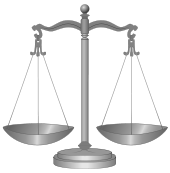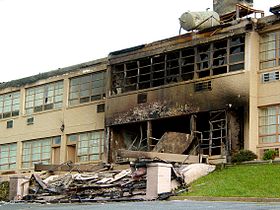- Arson
-
"Arsonists" redirects here. For the hip hop band, see Arsonists (rap group)."Torched" redirects here. For the Michael Hedges album, see Torched (album).

Criminal law Part of the common law series Element (criminal law) Actus reus · Mens rea
Causation · ConcurrenceScope of criminal liability Complicity · Corporate · Vicarious Inchoate offenses Attempt · Conspiracy · Solicitation Offence against the person Assault · Battery
False imprisonment · Kidnapping
Mayhem · Sexual assaultCrimes against property Arson · Blackmail · Burglary
Embezzlement · Extortion
False pretenses · Larceny
Possessing stolen property
Robbery · TheftCrimes against justice Compounding · Misprision
Obstruction · Perjury
Malfeasance in office
Perverting the course of justiceDefenses to liability Defense of self
Defence of property
Consent · Diminished responsibility
Duress · Entrapment
Ignorantia juris non excusat
Infancy · Insanity
Intoxication defense
Justification · Mistake (of law)
Necessity · Loss of Control (Provocation)Other common law areas Contracts · Evidence · Property
Torts · Wills, trusts and estatesPortals Criminal justice · Law  The Skyline Parkway Motel at Rockfish Gap after arson on July 9, 2004.
The Skyline Parkway Motel at Rockfish Gap after arson on July 9, 2004.
Arson[1] (or 'fire-raising', as it is known in Scotland) is the crime of intentionally or maliciously setting fire to structures or wildland areas.[2] It may be distinguished from other causes such as spontaneous combustion and natural wildfires. Arson often involves fires deliberately set to the property of another or to one's own property as to collect insurance compensation.[3]
Contents
Legal definitions
Common law
Arson (or fire-raising, as it is known in Scotland)[4] is defined as "the malicious burning of the dwelling of another"[5] in common law.
The elements are:
- The malicious
- burning
- of a dwelling
- of another
- malicious - for purposes of common law arson "malicious' means action creating a great risk of a burning. It is not required that the defendant acted intentionally or willfully for the purpose of burning a dwelling.
- burning - at common law charring to any part of dwelling was sufficient to satisfy this element. No significant amount of damage to the dwelling was required. On the other hand mere discoloration from smoke was insufficient. Actual damage the material from which the structure was built is required.[6] Damage to surface coverings such as carpets and wallpaper is insufficient.[6] Arson was not limited to the burning of wooden structures. Any injury or damage to the structure caused by exposure to heat or flame is sufficient.
- dwelling - dwelling means a place of residence.The destruction of an unoccupied building was not considered as arson, "[s]ince arson protected habitation, the burning of an unoccupied house did not constitute arson." At common law a structure did not become a residence until the first occupants had moved in and ceased to be a dwelling if the occupants abandoned the premises with no intention of resuming their residency.[7] Dwelling includes structures and outbuildings within the curtilage.[8] Dwellings were not limited to houses. A barn could be the subject of arson if it was occupied as a dwelling.
- of another - burning one's own dwelling does not constitute common law arson. However, for purposes of common law arson possession or occupancy rather than title determines whose dwelling the structure is.[8] Thus a tenant who sets fire to his rented house would not be guilty of common law arson,[8] while the landlord who set fire to a rented dwelling house would be guilty.
Furthermore, "[t]he burning of one's own dwelling to collect insurance did not constitute common law arson. It was generally assumed in early England that one had the legal right to destroy his own property in any manner he chose."[9]
United States
In the U.S., the common law elements of arson are often varied in different jurisdictions. For example, the element of "dwelling" is no longer required in most states, and arson occurs by the burning of any real property without consent or with unlawful intent.[10] Arson is prosecuted with attention to degree of severity[11] in the alleged offense. First degree arson[12] generally occurs when persons are harmed or killed in the course of the fire, while second degree arson occurs when significant destruction of property occurs.[13] While usually a felony, arson may also be prosecuted as a misdemeanor,[14] "criminal mischief", or "destruction of property."[15] Burglary also occurs, if the arson involved a "breaking and entering".[16] A person may be sentenced to death if arson occurred as a method of homicide, as was the recent case in California of Raymond Lee Oyler and in Texas of Cameron Willingham.
Some states, such as California, prosecute the lesser offense of "reckless burning" when the fire is set recklessly as opposed to willfully and maliciously.[17] The study of the causes is the subject of fire investigation.
England and Wales
In English law, arson was a common law offence[18] which was recently defined again and codified by the Criminal Damage Act 1971.[19]
See also: Criminal damage in English law#ArsonScotland
In Scots Law, the term "willful fire raising" is the equivalent term used instead of arson, but both mean the same.
See also
- Fire investigation
- Gävle goat
- Herostratus
- Insurance fraud
- John Leonard Orr
- John Magno
- Pyromania
- Reckless burning
- Vítkov arson attack of 2009
References
- ^ arson 1680, from Anglo-French. arsoun (1275), from Old French arsion, from L.L. arsionem (nom. arsio) "a burning," from L. arsus pp. of ardere "to burn," from PIE base *as- "to burn, glow" (see ardent). The Old English term was bærnet, lit. "burning;" and Coke has indictment of burning (1640). Arsonist is from 1864. Dictionary.com. Online Etymology Dictionary. Douglas Harper, Historian. [1] (accessed: January 27, 2008)
- ^ Kumar, Kris (February 2008). "Deliberately lit vegetation fires in Australia". Trends and issues in crime and criminal justice (Lynnwood: Australian Institute of Criminology) (350). ISBN 978 1 921185 71 7. ISSN 0817-8542. Archived from the original on 2008-07-22. http://web.archive.org/web/20080722133206/http://www.aic.gov.au/publications/tandi2/tandi350.html. Retrieved 2009-01-09.
- ^ arson. Dictionary.com. The American Heritage Dictionary of the English Language, Fourth Edition. Houghton Mifflin Company, 2004. Accessed: January 27, 2008)
- ^ "Annual Report of Her Majesty's Chief Inspector of Constabulary for Scotland 2005/2006". http://www.scotland.gov.uk/Publications/2006/11/29160835/4. Retrieved 2008-10-06.
- ^ 4 Blackstone, Commentaries (21st ed.) p. 220
- ^ a b http://en.wikipedia.org/wiki/Charring
- ^ Boyce & Perkins, Criminal Law, 3rd ed. (1992) at 280&81.
- ^ a b c Boyce & Perkins, Criminal Law, 3rd ed. (1992) at 281.
- ^ "Arson: Legal Aspects - Common Law Arson". Law Library - American Law and Legal Information. http://law.jrank.org/pages/535/Arson-Legal-Aspects-Common-law-arson.html. Retrieved 2008-05-10.
- ^ See U.S. v. Miller, 246 Fed.Appx. 369 (C.A.6 (Tenn.) 2007); U.S. v. Velasquez-Reyes, 427 F.3d 1227, 1230-1231 and n. 2 (9th Cir.2005).
- ^ "Campus Crime: Crime Codes and Degree of Severity". California State University, Monterey Bay. http://www.csumb.edu/site/x7006.xml. Retrieved 2008-05-10.
- ^ See U.S. v. Miller, 246 Fed.Appx. 369 (C.A.6 (Tenn.) 2007)
- ^ Garofoli, Joe (September 1, 2007). "Suspect in Burning Man arson decries event's loss of spontaneity". San Francisco Chronicle: p. A8. http://www.sfgate.com/cgi-bin/article.cgi?f=/c/a/2007/09/01/MN8LRTBBN.DTL. Retrieved 2008-05-11.
- ^ "Reason for Referral". Nebraska Commission on Law Enforcement and Criminal Justice. http://www.ncc.state.ne.us/statistics/data_search/jcr/jcr_referrals.htm. Retrieved 2008-05-11.
- ^ "Man accused of arson pleads to misdemeanor charges". The Salina Journal. January 25, 2008. http://www.saljournal.com/rdnews/story/Salinan_pleads_no_contest_to_misdemeanor_charges_1_25_08. Retrieved 2008-05-11.
- ^ 3 Charles E. Torcia, Wharton's Criminal Law § 326 (14th ed. 1980)
- ^ California arson and reckless burning laws under Penal Code 451 and 452
- ^ William Blackstone (1765–1769). "Of Offenses against the Habitations of Individuals [Book the Fourth, Chapter the Sixteenth]". Commentaries on the Laws of England. Oxford: Clarendon Press (reproduced on The Avalon Project at Yale Law School). http://www.yale.edu/lawweb/avalon/blackstone/bk4ch16.htm. Retrieved 2008-06-01.
- ^ "Criminal Damage Act 1971". www.opsi.gov.uk. http://www.opsi.gov.uk/RevisedStatutes/Acts/ukpga/1971/cukpga_19710048_en_1. Retrieved 2010-03-24.
Further reading
- Karki, Sameer (2002) (PDF). Community Involvement in and Management of Forest Fires in South East Asia. Project FireFight South East Asia. http://www.asiaforests.org/doc/resources/fire/pffsea/Report_Community.pdf. Retrieved 2009-02-13.
- White, J. & Dalby, J. T., 2000. Arson. In D. Mercer, T. Mason, M. McKeown, G. McCann (Eds) Forensic Mental Health Care. Edinburgh: Churchill Livingston. ISBN 0-443-06140-8
External links
 Media related to Arsons at Wikimedia Commons
Media related to Arsons at Wikimedia Commons
Wikimedia Foundation. 2010.
